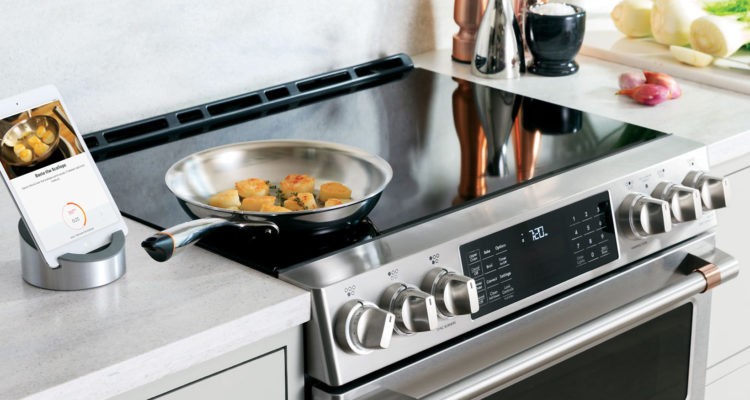Today’s cooktop is not necessarily your grandma’s cooktop.
Story by Ann Butenas
Not just for cooking, today’s cooktop makes a bold and intentional statement in the kitchen. With sleeker designs and more technological integration, cooktops boast a portfolio of options and capabilities that enthusiastically accommodate the aspiring chef in all of us. Whether on top of a range or holding its own within a fixed countertop, cooktops offer a great deal of flexibility in terms of burner size and style, as well as exiting options to appeal to tech-savvy consumers, such as touch controls, integrated grills and griddles, thermostatically controlled features, built-in down drafts, and Bluetooth connectivity.
Lloyd Doolittle at Doolittle Distributing, a wholesale appliance distributor, offered some insight as to the types of cooktops currently available and how finding the right one to serve your needs that can help you enjoy either the experience of gourmet cooking or simply creating an easy, tasty dish to enjoy. Deciding what type of cooktop you need largely depends in part on the type of cooking you do.
KCH&S: First of all, please clarify the difference between a range and a cooktop. Are they one in the same?
DOOLITTLE: While the terms “range” and “cooktop” are sometimes used interchangeably, a range is a one-piece appliance that includes a cooktop area with surface cooking using gas, electricity or induction and an oven down below. The oven can be either electric or gas. A cooktop installs in the countertop with controls generally on top. It functions like the cooktop area of a range but does not include an oven. Typically, a separate wall oven is used.
KCH&S: With cooktops available in gas, electric and induction versions, which do you see as being the most popular?
DOOLITTLE: Historically, people who cook a lot prefer gas. It is more powerful than electric and infinitely adjustable, as well as instantaneous. Magnetic induction, however, is becoming increasingly popular. It has many of the same attributes as a gas cooktop in that it is very powerful, highly adjustable, and even more instantaneous than gas. Plus, it cools down quickly and you are not in contact with hot iron grates like you are with gas cooktops. The smooth ceramic surfaces make them easy to clean.
KCH&S: What are some of the newer technological innovations incorporated into cooktops?
DOOLITTLE: New smart cooktops use magnetic induction technology in conjunction with stainless steel pans that include temperature sensors and the ability to “talk” with an app on a smart phone. In fact, Thomas Keller, the famed chef of The French Laundry restaurant, has developed recipes for this smart cooking system. To make a crepe, for example, the system tells you how to prepare the batter and then the app directs the smart pan to a very specific temperature via the smart cooktop. It tells you when to flip the crepe and when it’s done. As you do this, it will adjust the pan temperature so the crepe turns out perfectly.
KCH&S: Is it easy to install a magnetic induction cooktop?
DOOLITTLE: Basically, yes, but it depends on what you are replacing. Because magnetic induction requires 240 volts with up to 50 amps of power, if you are remodeling and replacing a cooktop that required only 120-volt power, you will need electrical modification. These cooktops are being used more frequently in new home construction.
KCH&S: Are electric cooktops still being used?
DOOLITTLE: Electric cooktops are not used as much as in the past in the luxury home category. However, they are still popular for moderately priced homes and multi-family housing. Many radiant electric cooktops include smooth ceramic cooking surfaces instead of electric coils.
KCH&S: What type of cooktop is best for someone who enjoys cooking a lot?
DOOLITTLE: People who really enjoy cooking aren’t necessarily looking for technology that will take the creativity out of cooking. Experienced cooks have developed a feel and a sense as they cook. They have their own way. These newer technologies tend to be attractive to less experienced cooks. Smart Cooktops are great teaching tools. You still use classic cooking techniques, i.e. boiling, steaming, frying, sautéing, pan roasting, etc., so it is not about creating a new cooking science. This new technology just makes it easier and more precise.
KCH&S: Can cooktops be personalized?
DOOLITTLE: Most cooktops cannot be customized but many will accept griddle or wok accessories. Other cooking appliances like ranges, rangetops, vent hoods, wall ovens and warming drawers are available in colors. Dishwashers and built-in refrigeration are often available in colors or will accept custom wood panels.
KCH&S: How much should I expect to spend on a magnetic induction cooktop?
DOOLITTLE: A 36-inch wide magnetic induction cooktop with all the bells and whistles will cost between $2,000 and $3,000. A 36-inch wide comparable gas cooktop will run about $1,600. Of course, the more sophisticated the brand, the higher the price tag.






